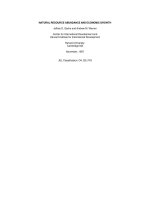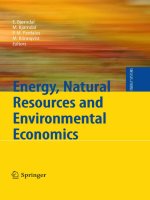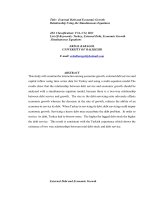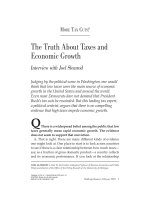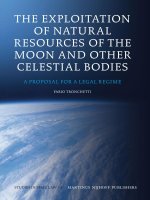- Trang chủ >>
- Khoa Học Tự Nhiên >>
- Vật lý
the global environment natural resources and economic growth jul 2008
Bạn đang xem bản rút gọn của tài liệu. Xem và tải ngay bản đầy đủ của tài liệu tại đây (937.84 KB, 219 trang )
The Global Environment, Natural
Resources, and Economic Growth
This page intentionally left blank
The Global Environment,
Natural Resources, and
Economic Growth
Alfred Greiner and Willi Semmler
1
2008
3
Oxford University Press, Inc., publishes works that further
Oxford University’s objective of excellence
in research, scholarship, and education.
Oxford New York
Auckland Cape Town Dar es Salaam Hong Kong Karachi
Kuala Lumpur Madrid Melbourne Mexico City Nairobi
New Delhi Shanghai Taipei Toronto
With offices in
Argentina Austria Brazil Chile Czech Republic France Greece
Guatemala Hungary Italy Japan Poland Portugal Singapore
South Korea Switzerland Thailand Turkey Ukraine Vietnam
Copyright © 2008 by Oxford University Press, Inc.
Published by Oxford University Press, Inc.
198 Madison Avenue, New York, New York 10016
www.oup.com
Oxford is a registered trademark of Oxford University Press.
All rights reserved. No part of this publication may be reproduced,
stored in a retrieval system, or transmitted, in any form or by any means,
electronic, mechanical, photocopying, recording, or otherwise,
without the prior permission of Oxford University Press.
Library of Congress Cataloging-in-Publication Data
Greiner, Alfred.
The global environment, natural resources, and economic growth/
Alfred Greiner, Willi Semmler.
p. cm.
Includes bibliographical references and index.
ISBN 978-0-19-532823-3
1. Economic development—Environmental aspects. 2. Pollution—Economic aspects.
3. Natural resources—Management. I. Semmler, Willi. II. Title.
HD75.6.G745 2008
333.7—dc22q 2007047160
987654321
Printed in the United States of America
on acid-free paper
“We have not inherited the earth from our ancestors, we have only borrowed it
from our children.”
—Ancient Proverb
“Act so that the effects of your action are compatible with the permanence of
genuine human life.”
—Hans Jonas (1903–1993),
German-born philosopher,
taught at the New School, 1955–1976
This page intentionally left blank
Preface
Recently public attention has turned toward the intricate interrelation
between economic growth and global warming. This book focuses on
this nexus but broadens the framework to study this issue. Growth
is seen as global growth, which affects the global environment and
climate change. Global growth, in particular high economic growth
rates, implies a fast depletionof renewable and nonrenewable resources.
Thus the book deals with the impact of economic growth on the envi-
ronment and the effect of the exhaustive use of natural resources as
well as the reverse linkage. We thus address three interconnected issues:
economic growth, environment and climate change, and renewable and
nonrenewable resources. These three topics and the interrelationship
among them need to be treated in a unified framework. In addition, not
only intertemporal resource allocation but also the eminent issues relat-
ing to intertemporal inequities, as well as policy measures to overcome
them, are discussed in the book. Yet more than other literature on global
warming and resources, we study those issues in the context of modern
growth theory. Besides addressing important issues in those areas we
also put forward a dynamic framework that allows focus on the appli-
cation of solution methods for models with intertemporal behavior of
economic agents.
The material in this book has been presented by the authors at
several universities and conferences. Chapters have been presented
as lectures at Bielefeld University; Max Planck Institute for Demo-
graphic Research, Rostock; Sant’Anna School of Advanced Studies of
Pisa, Itlay; University of Technology, Vienna; University of Aix-en-
Provence; Bernard Schwartz Center for Economic Policy Analysis of
the New School, New York; and Chuo University, Tokyo, Japan. Some
chapters have also been presented at the annual conference of the Soci-
ety of Computational Economics andthe Society of Nonlinear Dynamics
and Econometrics. We are grateful for comments by the participants of
those workshops and conferences.
Some parts of the book are based on joint work with co-authors.
Chapter 14 is based on the joint work of Almuth Scholl and Willi
Semmler, and chapter 15 originated in the joint work of Malte Sieveking
and Willi Semmler. We particularly want to thank Almuth Scholl and
Malte Sieveking for allowing us to use this material here.
vii
viii Preface
We are also grateful for discussions with and comments from Philippe
Aghion, Toichiro Asada, Buz Brock, Graciela Chichilnisky, Lars Grüne,
Richard Day, Ekkehard Ernst, Geoffrey Heal, James Ramsey, Hirofumi
Uzawa, and colleagues of our universities. We thank Uwe Köller for
research assistance and Gaby Windhorst for editing and typing the
manuscript. Financial support from the Ministry of Education, Science
and Technology of the State of Northrhine-Westfalia, Germany, andfrom
the Bernard Schwartz Center for Economic Policy Analysis of the New
School is gratefully acknowledged. Finally we want to thank numer-
ous anonymous readers and Terry Vaughn and Catherine Rae at Oxford
University Press, who have helped the book to become a better product.
Contents
Introduction 3
Part I The Environment and Economic Growth
1 Introduction and Overview 7
2 The Basic Economic Model 10
2.1 The Household Sector 10
2.2 The Productive Sector 11
2.3 The Government 12
2.4 Equilibrium Conditions and the Balanced
Growth Path 13
3 Growth and Welfare Effects of Fiscal Policy 17
3.1 Growth Effects of Fiscal Policy on the BGP 17
3.2 Growth Effects on the Transition Path 22
3.3 Welfare Effects of Fiscal Policy on the BGP
and the Social Optimum 26
3.3.1 Welfare Effects 26
3.3.2 The Social Optimum 28
4 The Dynamics of the Model with Standard
Preferences 31
5 Pollution as a Stock 39
5.1 The Household Sector 39
5.2 The Productive Sector and the Stock of Pollution 40
5.3 The Government 41
5.4 Equilibrium Conditions and the Balanced
Growth Path 41
5.5 The Dynamics of the Model 43
5.6 Effects of the Different Scenarios on
the Balanced Growth Rate 47
6 Concluding Remarks 51
x Contents
Part II Global Warming and Economic Growth
7 Introduction and Overview 55
8 Facts on GHG Emissions and the Change in
Average Global Surface Temperature 60
9 A Descriptive Model of Endogenous Growth 63
9.1 Structure of the Model 63
9.2 The Balanced Growth Path 65
9.3 Numerical Examples 68
10 The AK Endogenous Growth Model 71
10.1 The Second-Best Solution 72
10.2 The Social Optimum 75
10.3 A Multiregion World 77
10.3.1 The Noncooperative World 79
10.3.2 The Cooperative World 84
10.3.3 Equal Marginal Damages in All Regions 87
11 A Model with Optimizing Agents 89
11.1 The Competitive Economy 89
11.1.1 The Structure of the Economy 89
11.1.2 Analytical Results 92
11.2 The Social Optimum 100
11.3 Modeling Nonlinear Feedback Effects of the Rise in
Temperature 107
11.3.1 The Competitive Economy 109
11.3.2 The Social Planner’s Problem 116
12 Concluding Remarks 120
Part III Depletion of Resources and
Economic Growth 123
13 Introduction and Overview 125
14 Nonrenewable Resources 127
14.1 Introduction 127
14.2 Economic Growth with Resource Constraints 128
14.2.1 A Basic Model 128
14.2.2 Technological Change 130
14.2.3 The Role of Backstop Technology 132
Contents xi
14.3 The Importance of Intergenerational Equity 133
14.3.1 The Amenity Value of Natural Resources 133
14.3.2 Resources and Intergenerational Equity 135
14.4 Assessment of the Finiteness of Resources 137
14.5 Assessment of Petroleum Reserves 140
14.6 Estimation of a Basic Model 142
Appendix: Sketch of Solutions and Data Sources 145
15 Renewable Resources 157
15.1 Introduction 157
15.2 Renewable Resources and Optimal Growth 159
15.3 Open Access: Zero Horizon Optimization 166
15.3.1 Elasticity of Demand and Optimal Effort 166
15.3.2 Predator-Prey System 166
15.3.3 System of Competing Species 167
15.4 The Monopoly: Infinite Horizon Optimization 171
15.5 Concluding Remarks 175
Appendix 177
16 Regulation of Resources 180
16.1 Introduction 180
16.2 The Model 182
16.3 Numerical Results for the Partial
and Complete Model 184
16.4 Concluding Remarks 186
Appendix 188
17 Conclusion 190
Appendix: Three Useful Theorems from Dynamic
Optimization 194
Bibliography 197
Index 205
This page intentionally left blank
The Global Environment, Natural
Resources, and Economic Growth
This page intentionally left blank
Introduction
The globalization of economic activities since the 1980s and 1990s,
accelerated through free trade agreements, liberalized capital markets,
and labor mobility, has brought into focus the issues related to global
growth, resources, and environment. The industrialization in many
countries in the past 100 years and the resource-based industrial activi-
ties have used up resources, mostly produced by poor and developing
countries. Thetremendous industrial growth in the world economy, par-
ticularly since World War II, and the current strong economic growth in
some regions of the world, for example inAsia and some LatinAmerican
countries, have generated a high demand for specific inputs. Renewable
as well as nonrenewable resources have been in high demand, and they
are threatened with being depleted. In particular, the growing interna-
tional demand for metals and energy derived from fossil fuels, as well
as other natural resources, which are often extracted from developing
countries, has significantly reduced the years to exhaustion for those
resources.
It is true that technical progress has reduced the dependence of
modern economies on natural resources, which is beneficial for their
conservation, but this positive effect mostly holds for advanced
economies producing with up-to-date technologies. Developing nations
producing with older technologies usually do not have this advantage.
In addition, several of those countries have experienced high growth
rates over the past years. In particular, China and India have grown very
fast over the past decades. These two countries alone comprise a pop-
ulation of more than two billion citizens, and the high growth rates in
these countries have led to a dramatic increase in the demand for natural
resources.
Whereas modern economies, like those in Western Europe and
Japan, could reduce their dependence on nonrenewable resources, this
does not necessarily hold for renewable resources. In particular, many
oceans have been overfished for a long time. Current estimates assume
that about 75 percent of the worldwide fish population is overfished.
Although this problem has been realized by scientists and politicians, the
short-run gains seem to be more important than conservation, leading
to a severe threat to some fish species.
There is also an issue of inequity involved. An overwhelming frac-
tion of resources, located in the South, are used up in the North, in
3
4 Introduction
the industrialized countries, and the North has become the strongest
polluter of the global environment. Many recent studies have confirmed
that the emission of greenhouse gases is the main cause for global warm-
ing. Moreover, concerning intergenerational equity, current generations
extensively use up resources and pollute the environment. Both produce
negative externalities for future generations.
Indeed, not only does the environmental pollution strongly affect the
current generation, but the environmental degradation affects future
generations as well. It is true that as for the dependence on natu-
ral resources, technical progress has led to a more efficient use of
technologies so that emissions of some pollutants have been reduced
considerably. Indeed, in a great many regions in Europe and in the
United States, for example, air pollution has been successfully reduced,
leading to a cleaner environment. However, this does not hold for all
types of emissions. In particular, emissions of greenhouse gases are at
a high level and still increasing. Concerning greenhouse gas emissions,
the high standard of living of modern Western societies makes these
countries emit most of these gases, if measured per capita. Since the
conference and protocol of Kyoto in 1997, the global change of the cli-
mate has become an important issue for academics as well as politicians.
Although some countries had cast doubt on the fact that it is humankind
that produces a global climate change, this question seems to have been
answered now. There is vast evidence that the climate of the Earth is
changing due to increases in greenhouse gases caused by human activ-
ities (see, for example, the report by Stern 2006, 2007, and the IPCC
report 2007).
Although some may argue that to address and study those issues on
global growth, environment, and resources, large-scale macro models
may be needed. Yet when those models are solved through simulations,
the mechanisms get blurred, and policy implication are not transpar-
ently derived. This book takes a different route. In the context of modern
small-scale growth models, where the behavior of the agents and the
framework are well defined, clear and coherent results are derived that
may become useful guidelines for policy makers and practitioners.
The outline of the book reflects the discussed major issues. Part I
deals with the environment and growth. We present models that incor-
porate the role of environmental pollution into modern growth models
and derive optimal abatement activities as public policy. Part II models
global climate change in the context of economic growth models. Policy
implications are direct and transparent. Part III evaluates the use and
overuse of nonrenewable and renewable resources in the context of
intertemporal economic models. Aspects of global and intertemporal
inequities as well as policy measures to overcome them are discussed
in each part of the book.
PART I
The Environment and
Economic Growth
This page intentionally left blank
1
Introduction and Overview
There are numerous economic models that study the interrelation
between economic growth and the environment. We focus on a class of
models in which economic activities lead to environmental degradation,
and thus economic activity negatively affect the utility of households or
the production activities of firms. This line of research goes back to
Forster (1973) and was extended by Gruver (1976). Forster (1973), for
example, studies a dynamic model of capital accumulation, the Ramsey
growth model, with pollution as a byproduct of capital accumulation
that can be reduced by abatement spending. In the long run, this model
is characterized by a stationary state where all variables are constant
unless exogenous shocks occur.
Another early contribution in environmental economics is the book
by Mäler (1974), which can be considered as a classical contribution in
this field. Mäler analyzes several aspects associated with environmen-
tal degradation in different frameworks, such as a general equilibrium
model of environmental quality and an economic growth model incor-
porating the environment. But Mäler assumes a finite time horizon and
is less interested in the long-run evolution of economies, in contrast to
Forster (1973).
If one studies a growth model and intends to analyze the long-run
evolution of economies, models with constant variables in the long run
are rather unrealistic. With the publication of the papers by Romer (1986,
1990) the “new” or endogenous growth theory has become prominent.
The major feature of models within this line of research is that the growth
rate becomes an endogenous variable, the per capita income rises over
time, and the government may affect growth through fiscal policy, for
example. Concerning the forces that can generate ongoing growth, one
can think of positive externalities associated with investment, the for-
mation of human capital, or the creation of a stock of knowledgethrough
R&D spending (for a survey, see Greiner et al. 2005).
Another type of model in endogenous growth theory assumes that the
government can invest in productive public capital, which stimulates
aggregate productivity. This approach goes back to Arrow and Kurz
(1970), who presented exogenous growth models with that assumption
in their book. The first model in which productive public spending leads
to sustained per capita growth in the long run was presented by Barro
(1990). In his model, productive public spending positively affects the
7
8 The Environment and Economic Growth
marginal product of private capital and makes the long-run growth rate
an endogenous variable. However, the assumption that public spending
as a flow variable affects aggregate production activities is less plausible
from an empirical point of view, as pointed out in a study by Aschauer
(1989).
Futagami et al. (1993) have extended the Barro model by assuming
that public capital as a stock variable shows positive productivity effects
and then investigated whether the results derived by Barro are still valid
given their modification of the model. However, the assumption made
by these researchers implies that the model has transition dynamics,
which does not hold for the model when public spending as a flow
variable shows productive effects. In the latter case, the economy imme-
diately jumps on the balanced growth path. The model presented by
Futagami and colleagues is characterized by a unique balanced growth
path, which is a saddle point. Although the questions of whether the
long-run balanced growth path is unique and whether it is stable are
important issues, they are not frequently studied in this type of research.
Most of the contributions study growth and welfare effects of fiscal
policy for a model on the balanced growth path.
As to the question of whether public spending can affect aggre-
gate production possibilities at all, the empirical studies do not obtain
unambiguous results. However, this is not too surprising because these
studies often consider different countries over different time periods
and the effect of public investment in infrastructure, for example, is
likely to differ over countries and over time. A survey of the empirical
studies dealing with that subject can be found in Pfähler et al. (1996),
Sturm et al. (1998), Romp and de Haan (2005), and Semmler et al. (2007).
Problems of environmental degradation have also been studied in
endogenous growth models. There exist many models dealing with
environmental quality or pollution and endogenous growth (for a
survey, see, for example, Smulders 1995 or Hettich 2000). Most of these
models assume that pollution or the use of resources influences pro-
duction activities either through affecting the accumulation of human
capital or by directly entering the production function. Examples of
that type of research are the publications by Bovenberg and Smulders
(1995), Gradus and Smulders (1993), Bovenberg and de Mooij (1997),
and Hettich (1998). The goal of these studies, then, is to analyze how dif-
ferent tax policies affect growth, pollution, and welfare in an economy.
But as with the approaches already mentioned, most of these models do
not have transition dynamics or the analysis is limited to the balanced
growth path. An explicit analysis of the dynamics is often beyond the
scope of these contributions. An exception is provided by the paper
by Koskela et al. (2000), who study an overlapping generations model
with a renewable resource that serves as a store of value and as an
input factor in the production of the consumption good. They find that
Introduction and Overview 9
indeterminacy and cycles may result in their model, depending on the
value of the intertemporal elasticity of consumption.
In part I we analyze a growth model where pollution only affects util-
ity of a representativehousehold but does not affect productionactivities
directly through entering the aggregate production function. However,
there is an indirect effect of pollution on output because we suppose
that resources are used for abatement activities. Concerning pollution,
we assume that it is an inevitable byproduct of production and can be
reduced to a certain degree by investing in abatement activities. As
to the growth rate, we suppose that it is determined endogenously
and that public investment in a productive public capital stock brings
about sustained long-run per capita growth. Thus we adopt that type of
endogenous growth models that was initiated by Barro (1990), Futagami
et al. (1993), and others as mentioned.
Our approach is closely related to the contributions by Smulders and
Gradus (1996) and Bovenberg and de Mooij (1997), who are interested in
growth and welfare effects of fiscal policy affecting the environment but
do not explicitly study the dynamics of their models. Concerning the
structure, our model is similar to the one presented by Bovenberg and de
Mooij (1997) with the exception that we assume that public capital as a
stock enters the aggregate production function, whereas Bovenberg and
de Mooij assume that public investment as a flow has positive effects on
aggregate production.
In chapter 2 we present a simple variant of an economic model with
environmental pollution and productive public capital. This model will
be analyzed assuming a logarithmic utility function. Chapter 3 studies
both growth and welfare effects of fiscal policy. In particular, we analyze
how the long-run balanced growth rate reacts to fiscal policy and to the
introduction of a less polluting technology. Further, we study the effects
of fiscal policy, taking into account transition dynamics, and we ana-
lyze welfare effects of fiscal policy on the environment on the balanced
growth path as well as the social optimum. In chapter 4 we general-
ize our model and allow for a more general isoelastic utility function.
The goal, then, is to give an explicit characterization of the dynamic
behavior resulting from more general assumptions. An extension of the
model is presented in chapter 5 , where we assume that environmental
pollution as a stock negatively affects utility of the household. In this
variation of the model, we consider three different scenarios: first, we
analyze a scenario with a constant stock of pollution; second, we study
a scenario with an improving environmental quality; and finally, we
analyze a scenario in which environmental pollution grows at the same
positive rate as all other endogenous variables.
2
The Basic Economic Model
We consider a decentralized economy with a household sector, a pro-
ductive sector, and the government (see Greiner 2005a). First, we
describe the household sector. For reasons of simplicity we presume
here the household’s preferences to be logarithmic in consumption and
pollution.
2.1 THE HOUSEHOLD SECTOR
The household sector in our economy consists of many identical house-
holds, which are represented by one household. The goal of this
household is to maximize a discounted stream of utility arising from
consumption C(t) over an infinite time horizon subject to its budget
constraint:
max
C(t)
∞
0
e
−ρt
V(t)dt, (2.1)
with V(t) the instantaneous subutility function that depends positively
on the level of consumption and negatively on effective pollution, P
E
(t).
V(t) takes the logarithmic form
V(t) = ln C(t) − ln P
E
(t), (2.2)
with ln giving the natural logarithm.
1
ρ in (2.1) is the subjective discount
rate. Later in the book, at various places, we discuss further the impor-
tance of the discount rate for the solution of our models. Here it may
suffice to refer the reader to an important recent work on the discount
rate; see Weitzman (2007a,b).
The budget constraint for the household is given by
2
˙
K = (w + rK)(1 − τ) − C. (2.3)
The budget constraint (2.3) states that the individual has to decide how
much to consume and how much to save, thus increasing consumption
1
For a survey of how to incorporate pollution in the utility function, see Smulders
(1995), pp. 328–29.
2
In what follows we suppress the time argument if no ambiguity arises.
10
The Basic Economic Model 11
possibilities in the future.
3
The depreciation of physical capital is
assumed to equal zero.
The wage rate is denoted by w. The labor supply L is constant, sup-
plied inelastically, and we normalize L ≡ 1. r is the return to per capita
capital K, and τ ∈ (0, 1) gives the income tax rate.
To derive necessary conditions we formulate the current-value
Hamiltonian function as
H(·) = ln C − ln P
E
+ λ(−C + (w + rK)(1 − τ)), (2.4)
with λ the costate variable. The necessary optimality conditions are
given by
λ = C
−1
, (2.5)
˙
λ/λ = ρ − r(1 − τ), (2.6)
˙
K =−C + (w + rK)(1 − τ). (2.7)
Because the Hamiltonian is concave in C and K jointly, the necessary
conditions are also sufficient if in addition the transversality condition
at infinity lim
t→∞
e
−ρt
λ(t)K(t) = 0 is fulfilled. Moreover, strict concavity
in C also guarantees that the solution is unique (see the appendix and,
for more details, Seierstad and Sydsaeter [1987], pp. 234–35).
2.2 THE PRODUCTIVE SECTOR
The productive sector in our economy consists of many identical firms
that can be represented by one firm. The latter behaves competitively
and chooses inputs to maximize profits.
As to pollution P, we suppose that it is a byproduct of aggregate
production Y. In particular, we assume that
P(t) = ϕY(t), (2.8)
with ϕ = const. > 0. Thus, we follow the line invited by Forster (1973)
and worked out in more detail by Luptacik and Schubert (1982).
Effective pollution P
E
, which affects utility of the household, is that
part of pollution that remains after investing in abatement activities A.
This means that abatement activities reduce pollution but cannot elim-
inate it completely. As to the modeling of effective pollution, we follow
Gradus and Smulders (1993) and Lighthart and van der Ploeg (1994)
and make the following specification:
P
E
=
P
A
β
,0<β≤ 1. (2.9)
3
The dot over a variable gives the derivative with respect to time.
12 The Environment and Economic Growth
The limitation β ≤ 1 ensures that a positive growth rate of aggregate
production goes along with an increase in effective pollution, β<1, or
leaves effective pollution unchanged, β = 1. We make that assumption
because we think it is realistic to assume that higher production also
leads to an increase in pollution, although at a lower rate because of
abatement. Inlooking at the world economy, that assumption is certainly
justified. But it should also be noted that for β = 1 sustained output
growth goes along with a constant level of effective pollution, which
will be seen in detail in the next section. Further, we posit that A
β
> 1
holds such that effective pollution is smaller than pollution without
abatement, which is in a way an obvious assumption.
Pollution is taxed at the rate τ
p
> 0, and the firm takes into account
that one unit of output causes ϕ units of pollution, for which it has to pay
τ
p
ϕ per unit of output. The per capita production function is given by
Y = K
α
H
1−α
L
1−α
≡ K
α
H
1−α
, (2.10)
with H denoting the stock of productive public capital and α ∈ (0, 1)
giving the per capita capital share. Recall that K denotes per capita
capital and L is normalized to one.
Assuming competitive markets and taking public capital as given,
the first-order conditions for a profit maximum are obtained as
w = (1 − τ
p
ϕ)(1 − α)K
α
H
1−α
, (2.11)
r = (1 − τ
p
ϕ)αK
α−1
H
1−α
. (2.12)
2.3 THE GOVERNMENT
The government in our economy uses resources for abatement activities
A(t) that reduce total pollution. Abatement activities A ≥ 0 are financed
by the tax revenue coming from the tax on pollution, that is, A(t) =
ητ
p
P(t), with η>0. If η<1, not all of the pollution tax revenue is
used for abatement activities and the remaining part is spent for public
investment in the public capital stock I
p
, I
p
≥ 0, in addition to the tax
revenue resulting from income taxation. For η>1 a certain part of the
tax revenue resulting from the taxation of income is used for abatement
activities in addition to the tax revenue gained by taxing pollution. As
to the interpretation of public capital, one can think of infrastructure
capital, for example. However, one could also interpret public capital in
a broader sense so that it also includes human capital, which is built up
as a result of public education.
It should be mentioned that there are basically two approaches in
the economics literature to model abatement. The first assumes that
private firms engage in abatement (see Bovenberg and de Mooij 1997



